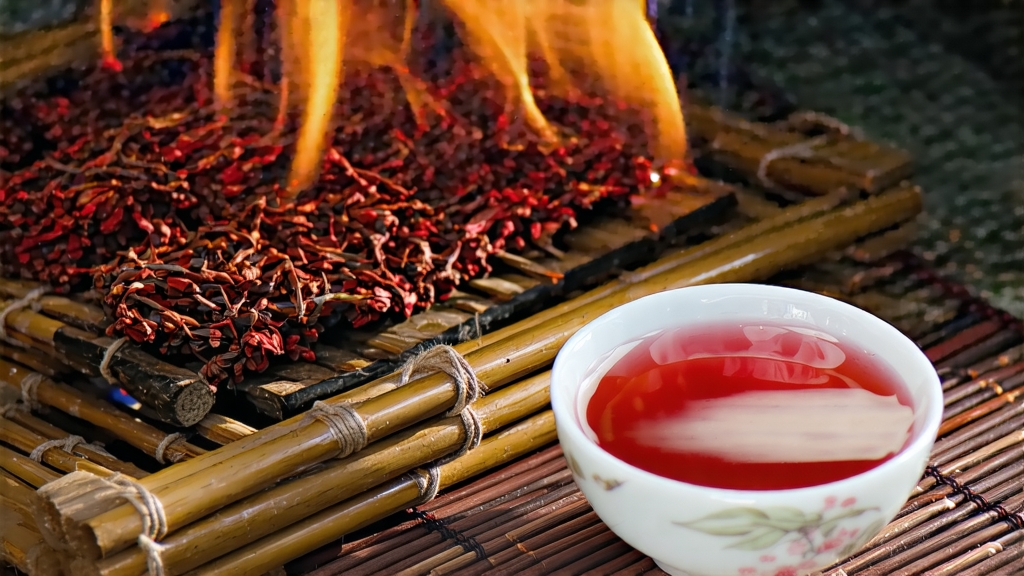
Ask most tea lovers to name China’s oldest black tea and they will answer Lapsang Souchong. Born in the cool, mineral-rich folds of the Wuyi range along Fujian’s border with Jiangxi, this leaf predates every other fully oxidised Chinese tea by at least two centuries. Local chronicles credit its accidental discovery to late-Ming soldiers who commandeered a monastery drying court; pressed for time, the monks hurried the withering leaves over nearby pine fires so the troop could march on. The resulting liquor—brisk, honey-sweet and wrapped in a scent that evoked camp-fires and resin—was an instant success with Dutch traders at the port of Xiamen, and by 1604 the first chests labelled “Bohea” (from the local dialect “Wuyi”) were changing hands in Amsterdam for the price of silver. Europe had tasted black tea; China had exported its first.
Yet Lapsang Souchong is not a single tea but a family of styles divided along two axes: geography and smoke. The original terroir lies within Tongmu Guan, a narrow, mist-locked pass where the Gan River cuts through granite cliffs. Here the village of Xingcun still produces “Zhengshan Xiaozhong”—literally “small-leaf from the original mountain”—using tea bushes seeded before 1850. Leaves are picked only in the five-day window around Qingming when the buds hold one and a half unfolded leaves, the so-called “sparrow’s tongue” standard. A kilometre lower in elevation, the town of Longchuan fashions “Waishan” versions from later plantings; larger leaf, faster oxidation, softer structure, they are the everyday face of Lapsang. Finally there is the modern “unsmoked” or “fruit-style” Xiaozhong, a twentieth-century adaptation that omits the final pine-firing to suit palates that prefer muscatel over ember.
Craft begins the moment the baskets reach the workshop. Sha Qing—kill-green—is skipped; instead the leaves are withered across bamboo slats suspended in the upper storey of a two-level wooden house. A gentle charcoal fire of local Masson pine smoulders below, raising the ambient temperature to 30 °C while resinous smoke drifts upward for six to eight hours. Oxidation follows in cloth-lined trays turned every thirty minutes; the leaf edges turn copper, then mahogany, releasing notes of longan and burnt sugar. When the master judges that 80 % of the cell walls have broken, the leaves are rolled under foot-powered wooden drums just long enough to twist the leaf into the tight barbed-hook shape that earned the name “souchong” (small, rolled). A second, hotter firing for fifteen minutes sets the aroma, after which the tea is moved to a pinewood room where a final 60 °C smoke bath lasts three to seven hours depending on the market. The best lots—Tongmu “Jin Jun Mei” grade—use only buds, no smoke at all, but that is another story; classic Lapsang exits the room cloaked in a fragrance that perfumers describe as “birch-tar, lapsang type”.
To brew Lapsang Souchong well is to balance its swaggering aroma against a surprisingly delicate body. Gongfu style is kindest: 5 g of leaf in a 120 ml porcelain gaiwan, water just off the boil at 95 °C. A flash rinse wakes the leaf, then the first proper infusion of ten seconds yields a liquor the colour of claret at the rim, burnt umber at the core. Lift the lid and the steam carries campfire, resin and a whisper of dried lychee; sip, and the tongue meets a split-second of pine that dissolves into cocoa, malt and a lingering note that Chinese cuppers call “longan honey”. Each steep adds five seconds; the tea will sing for seven, after which the smoke recedes and a clean mineral sweetness dominates. Western brewing works if you respect the leaf: one level teaspoon per 250 ml, three minutes, 90 °C, no milk or sugar needed—the liquor is already creamy.
Tasting notes are best charted on a spider diagram of five vectors: smoke, body, sweetness, acidity and after-impression. Premium Tongmu balances all five; lesser Waishan often shows blunt smoke and thin finish. Serve the tea in thin